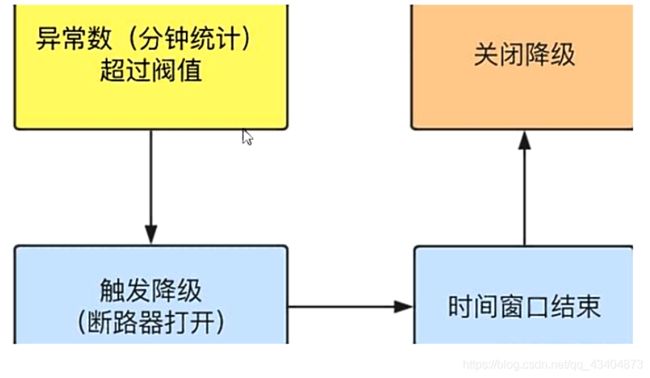SpringCloud学习笔记(十)----服务熔断与限流 Sentinel
SpringCloud Alibaba Sentinel实现熔断与限流
Sentinel概述
随着微服务的流行,服务和服务之间的稳定性变得越来越重要。Sentinel 是面向分布式服务架构的流量控制组件,主要以流量为切入点,从限流、流量整形、熔断降级、系统负载保护、热点防护等多个维度来帮助开发者保障微服务的稳定性。

Sentinel下载地址
安装Sentinel控制台
Sentinel组件由俩部分组成:后台和前台8080。
- 核心库(Java客户端)不依赖任何框架/库,能够运行于所有Java运行时环境,同时对Dubbo/SpringCloud等框架也有较好的支持。
- 控制台(Dashboard)基于Spring Boot开发,打包后可以直接运行, 不需要额外的Tomcat等应用容器。
下载到本地sentinel-dashboard-1.7.0.jar
运行命令:
- 前提:java8环境OK,8080端口不能被占用。
- 命令:java -jar sentinel-dashboard-1.7.0.jar
访问sentinel管理界面:
- http://localhost:8080
- 账号密码均为sentinel
微服务整合sentinel
1.启动Nacos
2.新建cloudalibaba-sentinel-service8401 Module
2.1 POM.xml
<dependencies>
<dependency>
<groupId>com.atguigu.springcloud</groupId>
<artifactId>cloud-api-commons</artifactId>
<version>${
project.version}</version>
</dependency>
<dependency>
<groupId>com.alibaba.cloud</groupId>
<artifactId>spring-cloud-starter-alibaba-nacos-discovery</artifactId>
</dependency>
<dependency>
<groupId>com.alibaba.csp</groupId>
<artifactId>sentinel-datasource-nacos</artifactId>
</dependency>
<dependency>
<groupId>com.alibaba.cloud</groupId>
<artifactId>spring-cloud-starter-alibaba-sentinel</artifactId>
</dependency>
<dependency>
<groupId>org.springframework.cloud</groupId>
<artifactId>spring-cloud-starter-openfeign</artifactId>
</dependency>
<dependency>
<groupId>org.springframework.boot</groupId>
<artifactId>spring-boot-starter-web</artifactId>
</dependency>
<dependency>
<groupId>org.springframework.boot</groupId>
<artifactId>spring-boot-starter-actuator</artifactId>
</dependency>
<dependency>
<groupId>org.springframework.boot</groupId>
<artifactId>spring-boot-devtools</artifactId>
<scope>runtime</scope>
<optional>true</optional>
</dependency>
<dependency>
<groupId>cn.hutool</groupId>
<artifactId>hutool-all</artifactId>
<version>4.6.3</version>
</dependency>
<dependency>
<groupId>org.projectlombok</groupId>
<artifactId>lombok</artifactId>
<optional>true</optional>
</dependency>
<dependency>
<groupId>org.springframework.boot</groupId>
<artifactId>spring-boot-starter-test</artifactId>
<scope>test</scope>
</dependency>
</dependencies>
2.2application.yml
server:
port: 8401
spring:
application:
name: cloudalibaba-sentinel-service
cloud:
nacos:
discovery:
server-addr: localhost:8848
sentinel:
transport:
dashboard: localhost:8080
port: 8719 #默认8719,假如被占用了会自动从8719开始依次+1扫描。直至找到未被占用的端口
management:
endpoints:
web:
exposure:
include: '*'
2.3主启动类
@EnableDiscoveryClient
@SpringBootApplication
public class MainApp8401 {
public static void main(String[] args) {
SpringApplication.run(MainApp8401.class,args);
}
}
2.4controller
@RestController
public class FlowLimitController
{
@GetMapping("/testA")
public String testA() {
return "------testA";
}
@GetMapping("/testB")
public String testB() {
return "------testB";
}
}
3.启动Sentinel8080 启动微服务8401
4.查看sentinel控制台,发现空空如也,啥都没有。是因为sentinel是采用懒加载,需要我们执行一次访问,才会有信息。
访问localhost/8401/testA

可以看到,已经开始监听了。
流控规则
基本介绍
- 资源名:唯一名称,默认请求路径。
- 针对来源:Sentinel可以针对调用者进行限流,填写微服务名,默认default(不区分来源)
- 阈值类型/单机阈值:
- QPS(每秒钟的请求数量):当调用该api的QPS达到阈值的时候,进行限流。
- 线程数:当调用该api的线程数达到阈值的时候,进行限流。
- 流控模式:
- 直接:api达到限流条件时,直接限流。
- 关联:当关联的资源达到阈值时,就限流自己。
- 链路:只记录指定链路上的流量(指定资源从入口资源进行的流量,如果达到阈值,就进行限流)【api级别的针对来源】
- 流控效果:
- 快速失败:直接失败,抛异常。
- Warm UP:根据codeFactor(冷加载因子,默认3)的值,从阈值/codeFactor,经过预热时长,才达到设置的QPS阈值。
- 排队等待:匀速排队,让请求以匀速的速度通过,阈值类型必须设置伟QPS,否则无效。
流控模式
直接->快速失败

快速点击访问http://localhost:8401/testA,直接失败的效果如下图:

线程数:

比如a请求过来,处理的慢,在一直处理,此时b请求又过来了,此时因为a占用一个线程,此时要处理b请求就只有额外开启一个线程,那么就会报错。
修改controller中testA方法,使用定时器来模拟业务处理请求比较慢的情况。
@GetMapping("/testA")
public String testA() {
try {
Thread.sleep(800);
} catch (InterruptedException e) {
e.printStackTrace();
}
return "------testA";
}
关联
当关联的资源达到阈值时,就限流自己。
一句话来说,当与A关联的资源B达到阈值后,就限流自己,B惹事,A挂了。
应用场景:比如支付接口达到阈值时,就要限流下订单的接口,防止一直有订单。

这里可以使用postman模拟并发密集访问testB,大批量线程高并发访问B,导致A失效了。 这时候再去访问testA,可以发现testA挂了。
链路
多个请求调用了同一个微服务。
流控效果
直接->快速失败(默认的流控处理)
直接失败,抛出异常
Blocked by Sentinel (flow limiting)
源码:
com.alibaba.csp.sentinel.slots.block.flow.controller.DefaultController
预热
公式:阈值除以coldFactor(默认值为3),经过预热时长后才会达到阈值。

Warmup配置:

应用场景:秒杀系统在开启的瞬间,会有很多流量上来,很有可能吧系统打死,预热方式就是为了保护系统,可慢慢的把流量放进来,慢慢的把阈值增长到设置的阈值。
排队等待:
降级规则
基本介绍
就是熔断降级。


Sentinel熔断降级会在调用链路中某个资源出现不稳定状态时(例如调用超时或异常比例升高),对这个资源的调用进行限制,让请求快速失败,避免影响到其它的资源而导致级联错误。
当资源被降级后,在接下来的降级时间窗口之内,对该资源的调用都自动熔断(默认行为是抛出DegradeException)。
Sentinel的断路器是没有半开状态的。
半开的状态系统自动去检测是否请求有异常,没有异常就关闭断路器恢复使用,有异常则继续打开断路器不可用,具体可以 参考Hystrix。
降级策略
RT
@GetMapping("/testD")
public String testD()
{
try {
TimeUnit.SECONDS.sleep(1); } catch (InterruptedException e) {
e.printStackTrace(); }
log.info("testD 测试RT");
return "------testD";
}
2.配置RT,这里的配置的RT,默认是秒级的平均响应时间。

默认计算平均时间是,1秒内进入5个请求,并且响应的平均值超过阈值(这里设置的200ms),就报错。 1秒5请求是Sentinel默认设置的。
测试:

后续停止jmeter,没有这么大的访问量了,断路器关闭(保险丝恢复),微服务恢复OK。
异常比例
@GetMapping("/testD")
public String testD()
{
// try { TimeUnit.SECONDS.sleep(1); } catch (InterruptedException e) { e.printStackTrace(); }
// log.info("testD 测试RT");
log.info("testD 测试RT");
int age = 10/0;
return "------testD";
}
2.配置

上面配置一句话来说,当1秒请求量>5,并且请求次数中出现异常的次数/总请求次数>0.2(我们设置的异常比例),就会出现服务熔断。
3.jmeter

4.结论:
按照上述配置,单独访问一次,必然来一次报错一次(int age = 10/0),调一次错一次。因为没有达到每秒的请求量>5。

开启jmeter后,直接高并发发送请求,多次调用达到我们的配置条件了。
断路器开启(保险丝跳闸),微服务不可用了,不再报错error而是服务降级了。

异常数


注意:异常数是按照分钟统计的。
一分钟内,有5个请求发生异常,进入熔断。
测试:
1.添加请求方法
@GetMapping("/testE")
public String testE()
{
log.info("testE 测试异常数");
int age = 10/0;
return "------testE 测试异常数";
}
热点key限流
何为热点?热点即经常访问的数据。很多时候我们希望统计某个热点数据中访问频次最高的Top K数据,并对其访问进行限制。比如:
- 商品ID为参数,统计一段时间内最常购买的商品ID并进行限制。
- 用户ID为参数,针对一段时间内频繁访问的用户ID进行限制。
热点参数限流会统计传入参数中的热点参数,并根据配置的限流阈值与模式,对包含热点参数的资源调用进行限流。热点参数限流可以看做是一种特殊的流量控制,仅对包含热点参数的资源调用生效。
比如:
- localhost:8080/aa?name=aa
- localhost:8080/aa?name=bb
- 这两个请求中,带有参数aa的请求访问频次非常高,我们就限制name=aa的请求,但是bb的不限制。
如何自定义降级方法,而不是默认的抛出异常?

使用@SentinelResource直接实现降级方法,它等同Hystrix的@HystrixCommand。
@GetMapping("/testHotKey")
//定义一个名字 //指定降级方法
@SentinelResource(value = "testHotKey",blockHandler = "deal_testHotKey")
public String testHotKey(@RequestParam(value = "p1",required = false) String p1,
@RequestParam(value = "p2",required = false) String p2) {
//int age = 10/0;
return "------testHotKey";
}
//兜底方法
public String deal_testHotKey (String p1, String p2, BlockException exception) {
return "------deal_testHotKey";
}
定义热点规则:

比如说:我们controller中,有两个参数p1,p2,这个参数索引0表示 是对p1进行限制,1表示对p2进行限制,以此类推。
测试:
此时我们访问/testHotkey并且带上p1,如果qps大于1,就会触发我们定义的降级方法。

如果我们的参数是p2,就没有问题。

如果修改controller为@SentinelResource(value = “testHotKey”),不指定降级方法。那么异常会打到前台用户界面,不太友好。
设置热点规则的其他选项
需求:

添加配置:

测试:

注意:
参数类型只支持8种基本类型+String类型。
注意:
如果我们程序出现异常,是不会走blockHander的降级方法的,因为这个方法只配置了热点规程,没有配置限流规则。
我们这里配置的降级方法是sentinel针对热点规则配置的。只有触发热点规则才会降级。

系统规则
系统自适应限流:从整体维度对应用入口进行限流。
对整体限流,比如qps到达100,这里限流会限制整个系统不可用。


测试:

这里设置了,如果QPS到达1,那么整个系统将不可用。

@SentinelResource
用于配置降级等功能。
按资源名称限流
1.启动Nacos+Sentinel成功。
2.为8401添加依赖,添加我们自己的common包的依赖
<dependency>
<groupId>com.atguigu.springcloud</groupId>
<artifactId>cloud-api-commons</artifactId>
<version>${
project.version}</version>
</dependency>
3.额外创建一个controller类
@RestController
public class RateLimitController {
@GetMapping("/byResource")
@SentinelResource(value = "byResource", blockHandler = "handleException")
public CommonResult byResource() {
return new CommonResult(200, "按资源名称限流测试OK", new Payment(2020L, "serial001"));
}
public CommonResult handleException(BlockException exception) {
return new CommonResult(444, exception.getClass().getCanonicalName() + "\t 服务不可用");
}
}
3.配置限流
注意,我们这里配置规则,资源名指定的是@SentinelResource注解value的值,这样也是可以的,也就是不一定要指定访问路径。

4.测试,可以看到已经进入降级方法了

5.此时,我们关闭8401服务,可以看到,这些定义的规则是临时的,关闭服务,规则就没有了。

按照Url地址限流
通过访问的URL来限流,会返回Sentinel自带默认的限流处理信息
1.controller中添加一个方法,用于测试
@GetMapping("/rateLimit/byUrl")
@SentinelResource(value = "byUrl")
public CommonResult byUrl()
{
return new CommonResult(200,"按url限流测试OK",new Payment(2020L,"serial002"));
}
2.Sentinel控制台配置

3.测试 返回Sentinel自带默认的限流处理信息

上面兜底方法面临的问题
- 系统默认的,没有体现我们自己的业务要求。
- 依照现有条件,我们自定义的处理方法又和业务代码耦合在一块,不直观。
- 每个业务方法都对应一个兜底的方法,代码膨胀加剧。
- 全局统一的处理方法没有体现。









